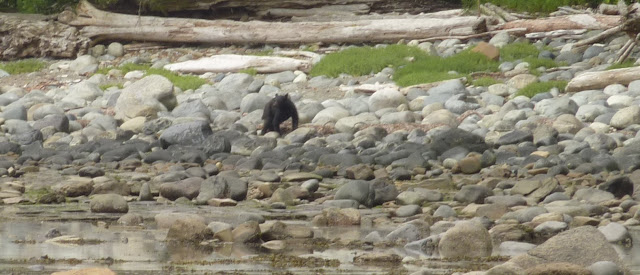The animals on this planet that have successfully taken over the planet in the last few thousand years had, in part, a stiff skeletal frame to thank for that. An internal bony structure frees us from the resource-intensive process of growing and shedding an exoskeleton, yet provides enough rigidity for us to leverage our muscles for strength and speed.
We humans have a natural tendency to identify most closely with other vertebrates - they are the animals closest to us in size, having behaviours that we are most familiar with. During the hike, we encountered many species for the first time, but it was the vertebrates that I was most excited to see.
We humans have a natural tendency to identify most closely with other vertebrates - they are the animals closest to us in size, having behaviours that we are most familiar with. During the hike, we encountered many species for the first time, but it was the vertebrates that I was most excited to see.

Sea otter tracks. One moonless night, long after the sun had set, I could make out the bouncing gait of a sea otter trotting through our campsite.
On our second beach day, a black bear foraged along the beach.
In the city, a bear-human encounter usually means the bear will either require relocation or extermination. A mandatory orientation session run by the Parks Board reminded all hikers that are the visitors. I was happy to see that animals were capable of living as animals without having to apologize for doing so. At each campsite, we were required to make use of locked metal bins within which any food we had would be stored. If those were full, then we'd hang our food up in a tree. Only by doing so could we keep animals such as bears from associated humans with a free meal.
Sea lions, lazing about on an island about 200 metres away.
For me, the highlight was seeing grey whales. But once we saw them, we couldn't not see them. Every few hours or so, another one would swim by. Occasionally, I'd see a few swimming in opposite directions, and could only imagine the conversation they'd have while passing each other (cue the whale talk from Finding Nemo)
Grey whales migrate from Alaska to California or Mexico in the mid to late summer, staying close to the shallows where food is plentiful. As benthic feeders, they sift for amphipods (the orange crustacean in the Spineless post) and other crustaceans from the muddy bottom.
The exhalations of the whales were loud enough that we'd be able to hear them above the din of the everpounding surf while in our tents.
I saw this egg case washed up on the beach; I recognized it as an egg case of either a shark or a skate. I've only seen one of these one other time in the wild (in California) so this was a treat. It was long dried, but I opened it up anyways; it was empty, so either this "mermaid's purse" was without an embryo, or the baby skate had already slipped out (once dried, it's difficult to determine whether there was an exit point). On further research, it seems like it belongs to a longnose skate.
An Osprey, hovering in the incoming winds, diving down into the surf periodically.
At the crab pier, I saw thousands of shiner perch hanging out, waiting for the crab entrails that would inevitably get thrown in.
Here's a video I made of all the wildlife we encountered.













No comments:
Post a Comment